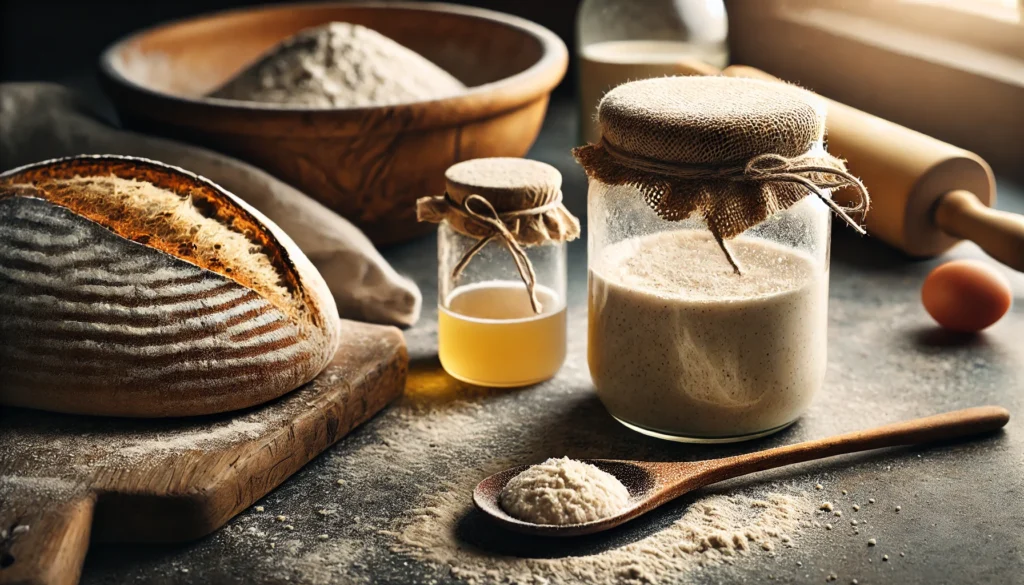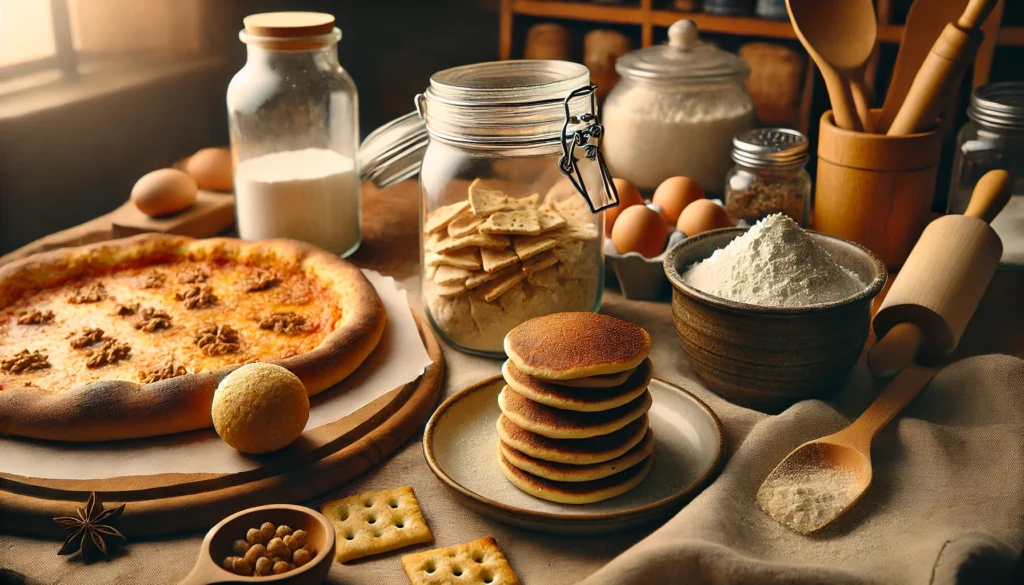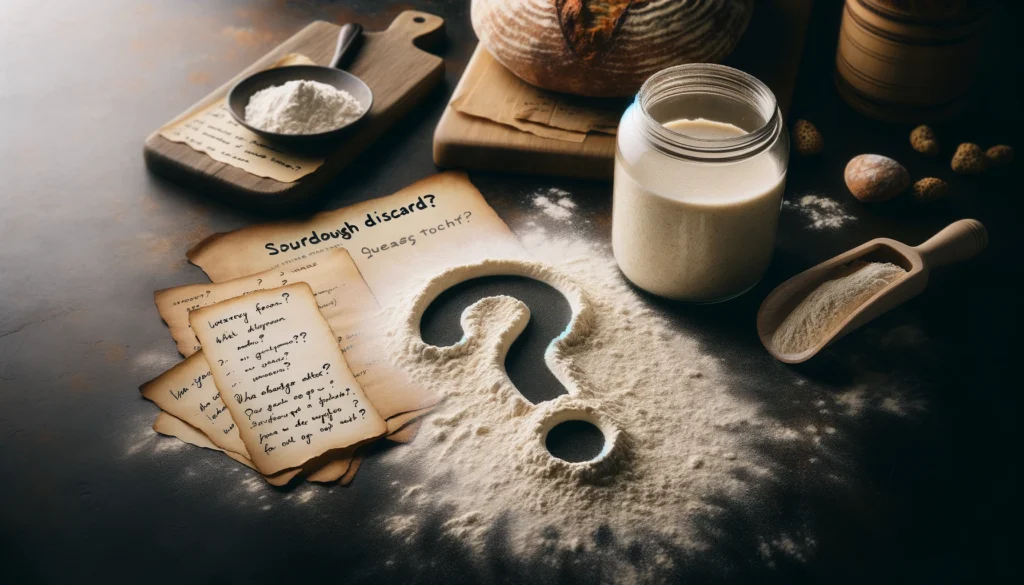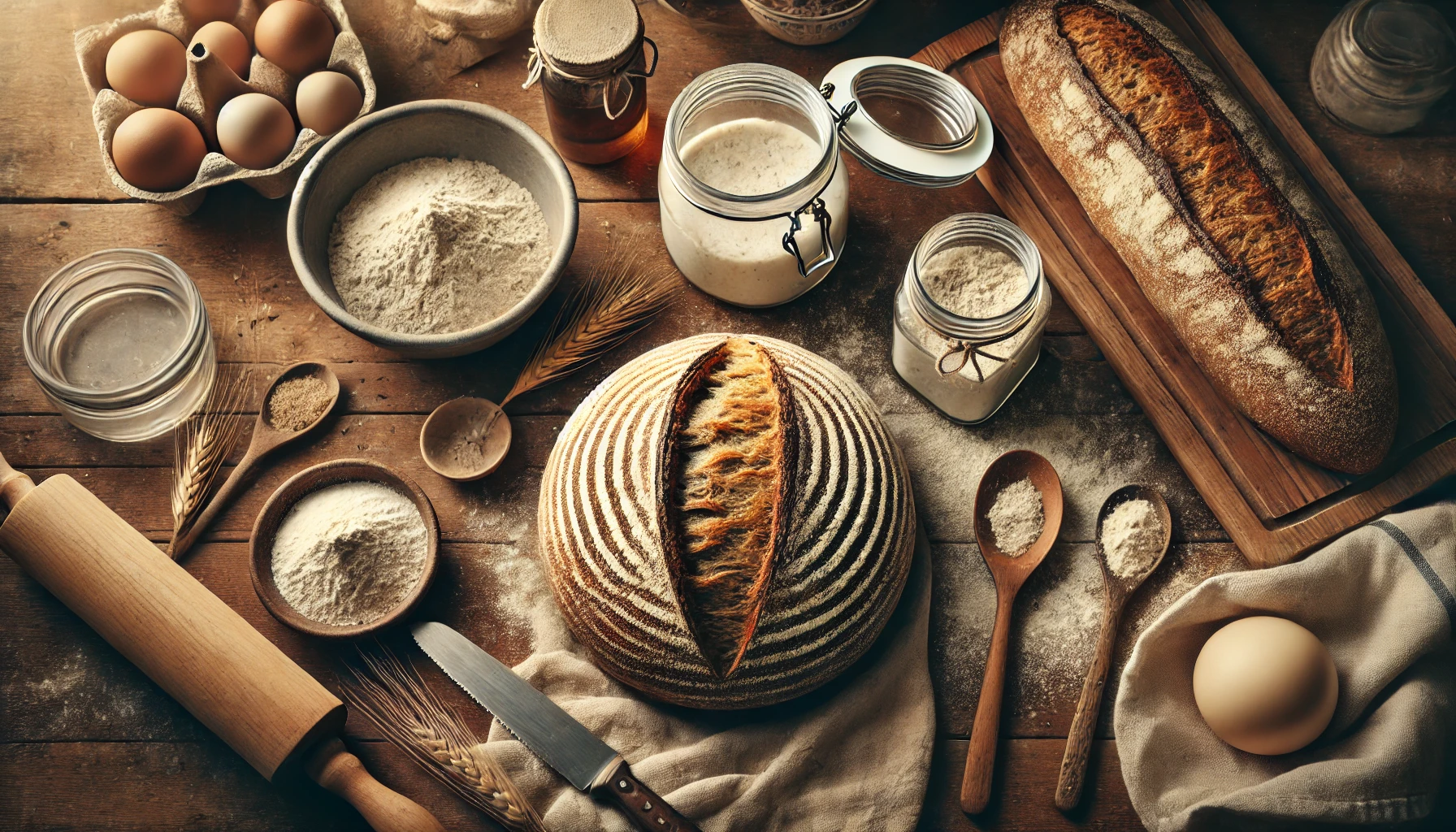Part 1: Introduction to Sourdough Discard

Understanding the Basics of Sourdough
Before diving into the topic of how long you can keep sourdough discard in the fridge, let’s first clarify what sourdough discard actually is. Each time you feed your sourdough starter, you remove a portion of it. This portion, which you take out, is what we call sourdough discard.
Now, you might wonder, why not simply toss it out? Interestingly, sourdough discard still holds plenty of value. Although it’s not as active as your starter, it contains natural yeast and bacteria that can impart a unique tangy flavor to various recipes. In other words, sourdough discard is a hidden gem in your kitchen, just waiting to be used.
The Importance of Proper Storage
You might have heard that sourdough discard can last for weeks in the fridge, and that’s true to an extent. However, without proper storage, its quality will degrade over time. Therefore, proper storage is crucial to ensuring your discard remains usable and safe for your culinary creations.
Furthermore, keeping your sourdough discard fresh is essential, especially if you plan to use it in a variety of recipes. Whether you’re making pancakes, crackers, or even starting a new bread batch, handling your discard correctly makes all the difference.
The Importance of Sourdough Discard in Baking
Sourdough discard is not just a byproduct; it’s a versatile ingredient with many uses. While many bakers initially feel puzzled about what to do with it, discard can actually add depth to your baked goods and help reduce waste in your kitchen.
By learning how to store and use your sourdough discard properly, you can open up a whole new world of baking opportunities. It’s about making the most out of what you have and ensuring nothing goes to waste.
Overview of What’s Ahead
In the sections that follow, we’ll explore the factors that impact the shelf life of sourdough discard. You’ll learn the best storage tips and find out exactly how long you can keep it in the fridge. Additionally, we’ll dive into creative ways to use your discard and answer some frequently asked questions. By the end of this guide, you’ll know how to manage your sourdough discard effectively, making sure it’s always ready for your next recipe.
Part 2: Factors Influencing Shelf Life in the Fridge

Factors Affecting the Shelf Life of Sourdough Discard
When it comes to storing sourdough discard, several factors influence how long it will stay fresh in the fridge. First and foremost, the temperature at which you store the discard plays a significant role. Ideally, your fridge should maintain a consistent temperature below 40°F (4°C). This helps slow down bacterial growth, keeping your discard safe to use for a longer period.
In addition, the hydration level of your discard affects its shelf life. A wetter discard may spoil faster than one that’s drier. Thus, if your discard has a high moisture content, you might need to use it sooner or store it more carefully. The presence of other ingredients, such as milk or sugar, can also impact how long your discard remains fresh. These additional ingredients may cause the discard to spoil more quickly, so it’s essential to consider them when assessing its shelf life.
Moreover, how you store the discard itself is crucial. Using an airtight container minimizes exposure to air, which can help prevent spoilage and extend the life of your sourdough discard. If you notice any changes in color, smell, or texture, these are signs that your discard may no longer be safe to use.
Typical Shelf Life of Sourdough Discard in the Fridge
So, how long can you keep sourdough discard in the fridge? On average, sourdough discard can last anywhere from one to two weeks when stored properly. However, its quality may start to degrade after the first week. If you plan to use your discard in baking, it’s best to do so within this timeframe to ensure the best results.
It’s important to note that while the discard may still be usable after two weeks, the flavor and activity level may not be as strong. Therefore, if you’re looking to use your discard in recipes that rely heavily on its natural yeast content, using it sooner rather than later is advisable.
Interestingly, some bakers have reported that their sourdough discard remains usable for up to a month, but this largely depends on the factors mentioned earlier, such as storage conditions and additional ingredients. In any case, always check your discard for any signs of spoilage before using it.
Signs That Sourdough Discard Has Gone Bad
Now, let’s talk about how to recognize when your sourdough discard has gone bad. The most obvious sign is a change in smell. Fresh sourdough discard has a pleasant, slightly tangy aroma. If your discard starts to smell off, sour in an unpleasant way, or even develops a musty odor, it’s likely spoiled and should be discarded.
Another sign to watch for is any change in color. Sourdough discard should maintain a consistent appearance. If you notice any unusual discoloration, such as pink, orange, or green spots, it’s a clear indication that mold has started to grow. In this case, it’s best to throw the discard away immediately.
Texture changes can also signal spoilage. If your discard has become overly slimy or has developed a strange consistency, it’s no longer safe to use. Lastly, if you see any visible mold growth, regardless of the amount, discard it immediately. Mold can quickly spread, even if it’s not apparent on the surface.
Part 3: Best Practices for Storing Sourdough Discard

Best Practices for Storing in the Fridge
To maximize the shelf life of your sourdough discard in the fridge, following proper storage practices is crucial. First, always store your discard in a clean, airtight container. This prevents exposure to air, which can lead to the growth of unwanted bacteria and mold. A glass jar with a tight-fitting lid works well for this purpose, as it’s easy to clean and doesn’t retain odors.
Next, place the container in the coldest part of your fridge, typically at the back of the bottom shelf. Keeping the discard in a consistently cold environment slows down the fermentation process and helps maintain its quality. Additionally, make sure to label the container with the date you stored the discard. This allows you to keep track of how long it’s been in the fridge and ensures you use it within its optimal timeframe.
Moreover, it’s a good idea to stir the discard occasionally if you’re storing it for more than a week. Stirring helps redistribute the natural yeast and bacteria, which can settle over time. This simple step can help maintain the consistency and usability of your discard.
Finally, consider the hydration level of your discard. If you prefer a thicker discard, you might want to add a bit more flour before storing it. A thicker consistency often lasts longer because it has less moisture, which can contribute to faster spoilage.
Alternatives to Fridge Storage: Freezing and Drying
If you’re not planning to use your sourdough discard within a week or two, there are other storage options to consider. Freezing is an excellent way to extend the shelf life of your discard. To freeze sourdough discard, simply portion it into smaller amounts and place it in airtight freezer bags or containers. When you’re ready to use it, thaw the discard in the fridge overnight. Freezing doesn’t significantly alter the discard’s flavor or properties, making it a convenient option for long-term storage.
Another method is drying your sourdough discard. Drying involves spreading a thin layer of discard on a piece of parchment paper and letting it air-dry for a couple of days. Once it’s completely dry, you can break it into pieces and store it in an airtight container at room temperature. To rehydrate, mix the dried discard with water until it returns to its original consistency.
Each of these methods—freezing and drying—offers a way to keep your sourdough discard usable for much longer than storing it in the fridge alone. Plus, they’re perfect for when you have more discard than you can use in a short period.
Part 4: Using Older Sourdough Discard

Is Older Sourdough Still Usable?
Now that you know how to store your sourdough discard properly, you might be wondering whether older discard is still usable. The good news is that, in many cases, you can still use sourdough discard that has been stored for a while. However, there are a few things to consider before diving into your older stash.
First, the flavor of older sourdough discard tends to be more intense. As the discard sits, the acidity level increases, which can give your baked goods a more pronounced tangy taste. While some bakers love this added complexity, others might find it a bit too strong, depending on the recipe.
Second, the activity level of the natural yeast in the discard may decrease over time. If your discard has been sitting for a few weeks, it might not have the same leavening power as fresh discard. This doesn’t mean it’s useless, though! Older discard is still great for recipes that don’t require a strong rise, such as pancakes, crackers, or flatbreads. In these recipes, the discard adds flavor without the need for significant fermentation.
Additionally, if your discard has developed a layer of liquid on top—often referred to as “hooch”—don’t panic. Hooch is simply a byproduct of fermentation and can be stirred back into the discard or poured off, depending on your preference. Just remember to check for any signs of spoilage, as discussed earlier, before using the discard.
Innovative Ways to Use Leftover Sourdough
Older sourdough discard can be incredibly versatile, opening up a world of creative culinary possibilities. Here are some ideas to help you make the most of your discard, even if it’s been sitting in the fridge for a while:
- Sourdough Pancakes: One of the most popular uses for sourdough discard is pancakes. The tangy flavor of the discard pairs perfectly with the sweetness of maple syrup, creating a delicious breakfast treat.
- Crackers: Sourdough discard is also excellent for making homemade crackers. Simply mix the discard with a bit of flour, salt, and your favorite herbs, then roll it out thin and bake. The result is a crispy, flavorful snack that’s perfect for dipping or pairing with cheese.
- Pizza Dough: Another great use for sourdough discard is pizza dough. The discard adds a unique depth of flavor to the crust, making your homemade pizza even more delicious. Just keep in mind that the dough might not rise as much if you’re using older discard.
- Quick Breads and Muffins: Older sourdough discard can be used in a variety of quick bread and muffin recipes. The acidity of the discard works well with baking soda, helping your baked goods rise without the need for additional yeast.
- Cakes and Cookies: Believe it or not, sourdough discard can even be used in cakes and cookies. The tangy flavor adds an interesting twist to sweet treats, making them stand out from the usual recipes.
Each of these ideas makes use of the unique properties of sourdough discard, allowing you to create a wide range of tasty treats. By experimenting with different recipes, you can find new and exciting ways to incorporate sourdough discard into your cooking and baking routine.
Part 5: FAQs About Sourdough Discard

How Long Can You Keep Sourdough Discard at Room Temperature?
If you’re wondering whether it’s safe to keep sourdough discard at room temperature, the answer is generally no, especially for extended periods. Sourdough discard, like any perishable food, can spoil quickly when left out. Ideally, you should store it in the fridge as soon as possible to maintain its quality and safety. If you do leave it at room temperature, try to use it within a few hours, particularly in cooler environments. However, in warmer climates, it’s best to avoid this practice altogether to prevent bacterial growth.
What Happens If Sourdough Discard Is Left Too Long in the Fridge?
Leaving sourdough discard in the fridge for too long can lead to several issues. Over time, the discard’s acidity increases, which can alter its flavor profile, making it overly tangy or even unpleasant. Additionally, the natural yeast activity diminishes, reducing its effectiveness in recipes that require fermentation. As the discard ages, it may also develop a layer of liquid, known as hooch, on top, which can indicate that it’s been sitting for too long. While hooch itself isn’t harmful and can be stirred back in, it’s a sign that your discard is past its prime.
Can You Refresh Sourdough Discard After Storing It?
Yes, you can refresh sourdough discard after storing it, but the results may vary depending on how long it has been in the fridge. To refresh it, feed the discard with equal parts of flour and water and let it sit at room temperature for several hours. This process can help revive some of the yeast activity, though it might not be as vigorous as fresh discard. If you plan to use the discard in a recipe that relies on its rising power, testing it beforehand is a good idea to ensure it’s still effective.
How Can You Tell If Sourdough Discard Is Still Good?
Determining whether sourdough discard is still good involves checking a few key factors. First, give it a sniff—fresh discard has a mildly tangy aroma. If it smells unpleasant, sour in a bad way, or musty, it’s likely spoiled and should be discarded. Next, examine the color and texture. Fresh discard should have a consistent appearance without any unusual colors like pink, orange, or green, which could indicate mold growth. Additionally, if the discard has become overly slimy or has a strange texture, it’s best not to use it. Lastly, any visible mold on the surface means the discard has gone bad and should be thrown away immediately.
Part 6: Conclusion
Summarizing the Key Points
In this guide, we’ve explored sourdough discard from every angle—what it is, how to store it, and how long it lasts in the fridge. Typically, you can keep sourdough discard in the fridge for one to two weeks, provided it’s stored correctly. Using an airtight container and placing it in the coldest part of the fridge are key steps in preserving its quality.
We also discussed alternative storage methods like freezing and drying. These methods can extend the shelf life of your discard, giving you more flexibility. Recognizing spoilage signs is crucial, too, so you can avoid using discard that has gone bad.
Moreover, we explored creative ways to use older sourdough discard. Whether you’re whipping up pancakes, making crackers, or crafting pizza dough, sourdough discard can be a versatile ingredient. The FAQs section provided answers to common questions, helping you manage your discard with confidence.
Final Thoughts on Sourdough Discard Storage

Proper storage of sourdough discard not only reduces waste but also opens up a world of culinary possibilities. By following the best storage practices, you ensure your discard stays fresh and ready to use. Whether you’re an experienced baker or a sourdough beginner, understanding how to handle your discard is essential.
Remember, sourdough discard is more than just a leftover—it’s a valuable ingredient. By storing it well and using it creatively, you can enhance your baking and discover new flavors.

